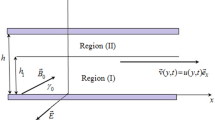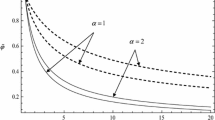Summary
We consider the impulsively generated magnetohydrodynamic flow at a rear stagnation point. The work of Leibovich is carried further by formulating the inner viscous problem and providing analytical solutions and complete numerical solutions for the entire range of the interaction parameter. It is shown that the present results are consistent with previously obtained numerical solutions to the steady equations of both similarity and non-similarity form.
Résumé
Nous considérons l'écoulement magneto-hydrodynamique impulsivement engendré à un point de stagnation arrière. On porte plus loin l'étude de Leibovich par la formulation du problème visqueux intérieur et en fournissant des solutions analytiques et numériques complètes correspondantes au champ entier du paramètre d'interaction. On montre que les résultats actuels sont en accord avec les solutions numériques, et de similitude et de non-similitude, déjà connues des équations stationnaires.
Similar content being viewed by others
References
V. J. Rossow,On flow of electrically conducting fluids over a flat plate in the presence of a transverse magnetic field NACA TN 3971 1957 (see also NACA TR 1358 1958).
A. Tsinober, A. Shtern, and E. Shcherbinin,On the separation of the magnetohydrodynamic boundary layer. Latvijas PSR Zinatnu Akad. Vestis12, 49–56 (1963). (Also Foreign Technology Div, Air Force Systems Command, Wright-Patterson Air Force Base, Ohio, U.S.A. FTD-TT-65-27).
R. Moreau,L'effet d'un champ magnétique transversal sur le décollement. C.r.hebd. Séanc. Acad. Sci., Paris,258, 1732–1735 (1964).
S. Leibovich,Magnetohydrodynamic flow at a rear stagnation point. J. Fluid Mech.,29, 401–413 (1967).
I. Proudman and K. Johnson,Boundary-layer growth near a rear stagnation point. J. Fluid Mech.,12, 161–168 (1962)
J. Buckmaster,Separation and magnetohydrodynamics. J. Fluid Mech.,38, 481–498 (1969).
J. Buckmaster,Boundary layer structure at a magnetohydrodynamic rear stagnation point. Quart. J. Mech. Appl. Math., XXIV, 373–386 (1971).
A. J. Robins and J. A. Howarth,Boundary-layer development at a two-dimensional rear stagnation point. J. Fluid Mech.,56, 161–171 (1972).
G. S. S. Ludford,Hydromagnetic stagnation-point flow for small R m. ZAMM43, 9–24 (1963).
L. Rosenhead,Laminar Boundary Layers, OUP (1963).
W. H. H. Banks and M. B. Zaturska,The collision of unsteady laminar boundary layers. J. Engng. Math.,13, 193–212 (1979).
Author information
Authors and Affiliations
Rights and permissions
About this article
Cite this article
Banks, W.H.H., Zaturska, M.B. The flow of an electrically conducting fluid at a rear stagnation point. Z. angew. Math. Phys. 35, 72–80 (1984). https://doi.org/10.1007/BF00945177
Received:
Issue Date:
DOI: https://doi.org/10.1007/BF00945177




